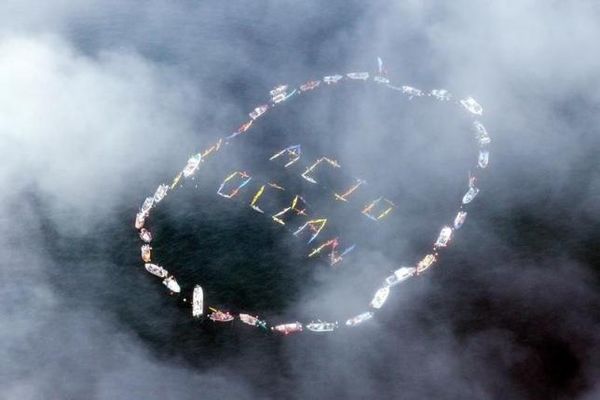Acidic oceans implicated in Earth's worst mass extinction
Date: 10-Apr-15
Country: USA
Author: Will Dunham

Commercial fishermen and other mariners form the words ''Acid
Ocean'' during an event held to spread the message of saving the
oceans from acidification caused by fossil fuel emissions, in Homer,
Alaska, in this file photo taken on September 6, 2009.
Photo: Lou Dematteis
It is one of science's enduring mysteries: what caused the worst mass extinction in Earth's history. And, no, it is not the one that wiped out the dinosaurs.
Scientists said on Thursday that huge amounts of carbon dioxide spewed from colossal volcanic eruptions in Siberia may have turned the world's oceans dangerously acidic 252 million years ago, helping to drive a global environmental calamity that killed most land and sea creatures.
The researchers studied rocks in the United Arab Emirates that were on the seafloor at the time and contained a detailed record of the changing ocean conditions at the end of the Permian Period.
"This is one of the few cases where we have been able to show that an ocean acidification event happened in deep time," said University of Edinburgh geoscientist Rachel Wood, one of the researchers in the study published in the journal Science.
"This is significant because we believe our modern oceans are becoming similarly acidic," Wood added. "These findings may help us understand the threat posed to marine life by modern-day ocean acidification."
Various hypotheses have been offered to explain the mass extinction that exceeded even the one 65 million years ago caused by an asteroid impact that erased the dinosaurs and many other animals. The researchers said ocean acidification had long been suspected but no direct evidence had been found until now.
Massive eruptions that formed an immense region of volcanic rock called the Siberian Traps represented one of the largest volcanic events of the past half billion years, lasting a million years and spanning the boundary between the Permian and subsequent Triassic Period.
The prodigious amounts of carbon dioxide from the eruptions had awful consequences for land and marine life. The absorption of carbon dioxide lethally, but temporarily, changed the chemical composition of the oceans, the researchers said.
The mass extinction unfolded over a period of 60,000 years, they said.
The horseshoe crab-like trilobites and the sea scorpions - denizens of the seas for hundreds of millions of years - were among the many marine creatures that vanished.
Land animals faced global warming and a general drying of the climate. Most of the dominant mammal-like reptiles died, with the exception of a few lineages including the ones that were the ancestors of modern mammals including people.
The mass extinction also paved the way for the first dinosaurs about 20 million years later.
(Editing by Mohammad Zargham)
![]()
© Thomson Reuters 2015 All rights reserved